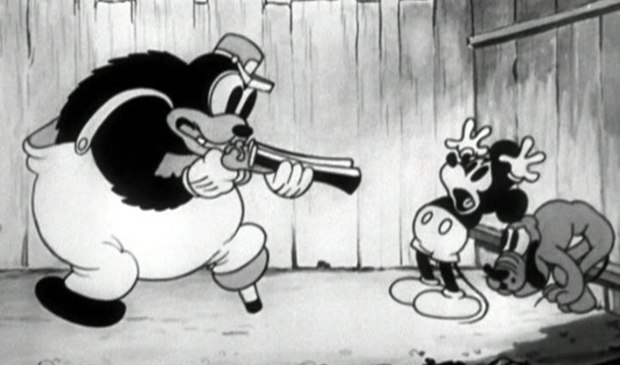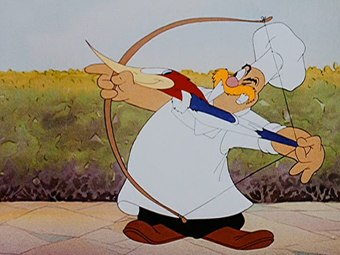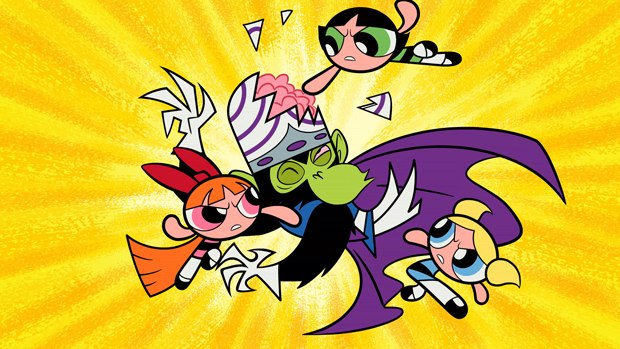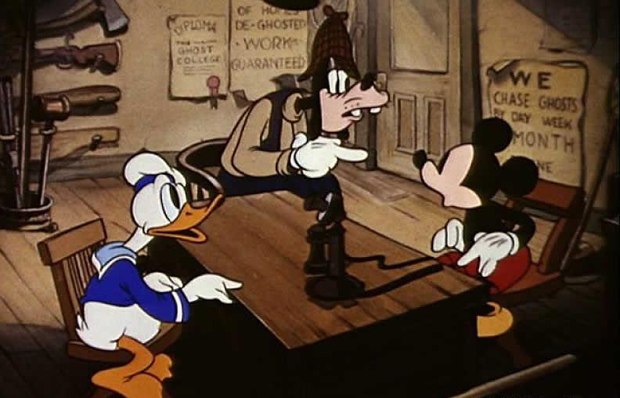Dr. Toon gets deeper into conflict and character.
Any writers of fiction, stage or screenplays know that without conflict, dramatic narrative is not possible. Conflict is the engine that drives story; characters are the actors that play it out. When one has a seven or eight-minute cartoon or a 90-minute animated feature film to produce, conflict must be immediately defined, clearly delineated, and carried through to a successful conclusion that resolves the conflict-driven tension. Even if the conflict is in a single episode of an ongoing series (very common in anime titles), that particular episode must contain enough conflict to keep an audience interested.
In the early days of animation, the protagonist tended to be a helpless little guy up against a brutish, bigger one, and most conflicts were physical rather than cerebral; this was perfectly in keeping with the primitivism of an early art form. For a quick example, Mickey Mouse squared off against (some variant of) Pegleg Pete. At times, the protagonist struggled against the environment, and cartoons featuring hunger and the pursuit of food often provided the basis for conflict.
Such was the origin of the "chase" cartoon, in which one character pursues the other throughout the film, usually out of anger, hunger, or sport. Some animation analysts, such as Norman Klein, see the chase and its variants as the basic structure underlying animated cartoons. However, one must keep in mind that any chase is the product of conflict.
Rule Number One: The intensity of conflict in a cartoon film is directly related to the stakes involved. A character out to make money is playing for lower stakes than a character who is trying to avoid being eaten. A character who must overcome obstacles to steal a tasty pie from a windowsill is playing for lower stakes than one who is starving to death, and so on.
In a good cartoon, conflict is complicated and multi-layered, testing a character's resolve and ingenuity. Let's say we have Woody Woodpecker frantic with hunger, as he often was. There's food, but Woody must first get through a locked door. That's a basic conflict. Now let's add Wally Walrus, who has the only key to the door. Woody now has to defeat Wally, adding another layer of conflict. Woody's ingenious attempt to get the key forces Wally to make it more inaccessible by swallowing it. The level of conflict is upped, over half the cartoon is over, and we are left wondering how -- and if -- Woody can reach his goal before the cartoon ends with the woodpecker crying from hunger pangs. Experience tells us that he will assuredly triumph, but wouldn't you be curious as to how? In contrast, consider the short-lived and unsuccessful series produced by the dying Warner Bros. studio from 1968-1969, Bunny and Claude. No one could emotionally invest in stories based on the theft of carrots, and audience didn't.
Rule Number Two: Conflict must be staged so that the protagonist and the forces he is in conflict with make the outcome uncertain. Sans spinach, Bluto is as strong as Popeye. Fred Flintstone can hatch a ruse with the best of them, but Wilma is miles ahead of him every time. Tom and Jerry seem to possess equal lethality, but the balance of power can shift several times in one of their shorts. The heroes of Toy Story 3 had to defeat an anti-woody and his toy cohorts, and were nearly ground to shards and incinerated in the struggle.
Without an uncertain outcome, the cartoon is a bust. This is the reason why many of the Harveytoons featuring Herman and Katnip failed; when watching any of them, it is difficult to believe that this is an even matchup. Thus, conflict tended to be solved by one-sided violence. It is also the reason why Mighty Mouse was an unexciting character. When Ben Edlund created the superhero satire The Tick, both the good and evil characters were powerful, but equally stupid and/or inept. Even though the series was played for laughs, it followed the rules of successful conflict, and thus became a hit.
For some time, Bugs Bunny did well outwitting and outhitting idiots like Elmer Fudd, or a nameless African-American hunter or a stupid American Indian stereotype. Potentially dangerous foes like Red-Hot Ryder were too mentally slow to challenge Bugs. The Warner stable of directors quickly figured out that Bug's foes had to be more powerful, and Yosemite Sam, Marvin Martian and the Tazmanian Devil filled the bill. This is one good reason why Bugs Bunny is still around and Herman the Mouse isn't.
Rule Number Three: The protagonist ought to win and the more unexpected the triumph, the more satisfying the outcome. Imagine how audiences would react if Snow White died from the poisoned apple, Brak killed Space Ghost, Dr. Zinn blew up Dr. Quest's plane in mid-flight, or Mojo Jojo vaporized the cute Powerpuff Girls. Such events should exist as a possibility or a viable threat, but they cannot come to completion unless the director/writer actually intends a tragedy. More on this later.
We are hooked when Wile E. Coyote hatches each scheme, if only to see how the Road Runner escapes destruction. Recall some of the Popeye cartoons wherein the sailor, in mortal danger, is unable to reach his spinach. How about Daffy Duck, surrounded by a squadron of Chester Gould-inspired super criminals? Or Price Philip facing a malevolent hell spawn of a dragon to save his beloved? A triumphant dénouement, when well staged, holds our attention and creates satisfying art.
A second sort of conflict also deserves examination, and this concerns the protagonist against self. Many hilarious and noteworthy cartoons were generated using this simple premise. It took a few years until this sort of cartoon developed. While Popeye battled Bluto in the beloved classic Fleischer shorts, Warner Bros. was producing sport hunter vs. crafty game fare. The short-lived Iwerks studio was pitting Flip the Frog against ghosts, bullies, robots and mean bosses. The Disney studio, however, was experimenting with characters that created their own conflicts. There was no seminal cartoon that exemplified this style; rather, it was the result of slow evolution as personality animation was perfected.
Donald Duck was the penultimate example of conflict within the self. Donald would battle various pests throughout his explosive career, but the early version of the duck was that of a bomb waiting to go off. Donald would even take on inanimate objects, which always seemed to have a sneaky way of striking back. Cartoons such as the aptly named Self Control (1938) featured the duck taking the advice of a radio host that advised him to count to 10 whenever a tantrum loomed. Naturally, the challenges are legion, and in the end, Donald's losing battle to keep his cool supplies the fun and it's the radio that's smashed to bits.
Another Disney character, Goofy, struggled against himself, but not because of his temperament. Goofy's problems were physically generated through incompetence, an intransigent environment, or Goofy's belief that he could master any situation if he rolled up his sleeves and practiced persistence. There were further difference between Donald and Goofy; in Donald's cartoons, the objects of his ire seemed to possess a sadistic spirit that struck somehow struck back at him and his rages. Goofy's mishaps were the result of impersonal accidents and disasters resulting from his own misguided actions.
It can be argued that these two characters set the tone for self-defeating characters. This sort of conflict is fun because we root both for and against the protagonist. Anytime a character has to act against himself or behave in ways that do not conform to his personality, we can enjoy the comeuppance and resultant humility. An example: Timmy Turner, despite having the help of not one, but two omnipotent Fairly Oddparents, was his own worst enemy. At times Wanda and Cosmo would look at each other in weary resignation before granting Timmy's stupid or selfish wishes. Timmy lacked insight much of the time, and could not foresee consequences. To put it simply, he got everything he deserved. Yet, no one watching the show wanted anything truly bad to happen to Timmy; we just enjoyed the entertaining way he learned his lessons.
Of course, there are examples of animation in which both types of conflict ends in defeat; witness Chris Landreth's fascinating, harrowing short film Ryan, in which a talented animator loses a battle against his own self-destructive tendencies. Again, heroes often meet defeat and even death at the hands of their foes in manga-based anime.
This leads us to the final rule: The settlement of conflict in cartoons varies with the sophistication of the characters, story, and plot; the higher the level, the more options a writer/director/animator has. Protagonists can be maimed or killed if a complex storyline demands it. Ashitake, the hero of Princess Mononoke, spends most of the film dying. The two protagonists in Grave of the Fireflies are both dead before the film begins. Some protagonists die in an act of sacrifice, something one would certainly never see in a Felix the Cat or Heckle and Jeckle cartoon.
However a cartoon film or short may end, one thing is universally certain: Without a solid conflict at its core, it may as well not even begin.
Next month: Semester Break! Time for some fun from your doctor of toons.
Martin "Dr. Toon" Goodman is a longtime student and fan of animation. He lives in Anderson, Indiana.











